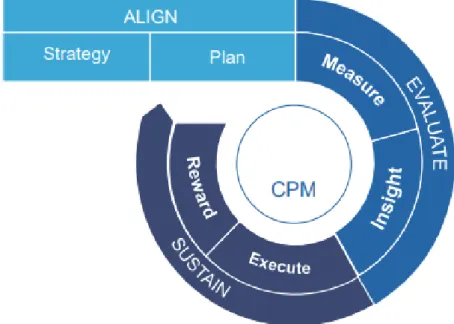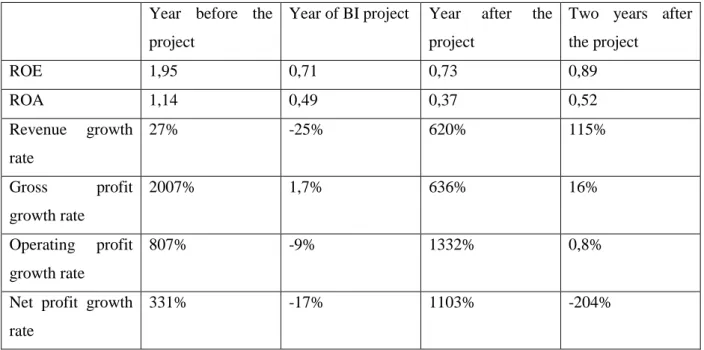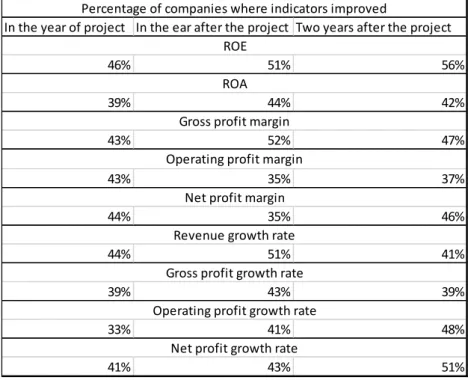Master's topic title Impact of business intelligence systems on corporate performance of Russian companies. The main results of the study are that BI positively affects the overall corporate performance of Russian companies, but does not affect financial performance. Therefore, the main hypothesis of the research paper is as follows: the use of Business Intelligence solutions leads to better corporate performance of Russian companies.
Examining Previous Studies in BI
Theory and Historical Development of Business Analytics
11 The first mentions of business analytics in scientific research were in the middle of the 20th century, in the 40s of the 20th century, when the first computers came into practical use2. But in the middle of the last century, huge companies had to keep large manual databases, printed somewhere. In the 20th century, there were many findings that contributed to the establishment of statistics.
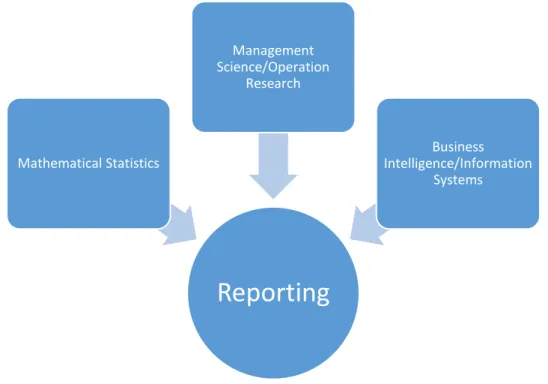
Components of Modern Business Intelligence System
- Data Warehousing
- Online Analytical Processing (OLAP)
- Advanced analytics
- Corporate Performance Management
- Real Time BI and Data Sources
To overcome this problem, the databases are sometimes shut down at night when they are not needed, or the data is restored in parallel (multiple databases are needed to perform this task: one is running, and one remains saved in the state before actions are applied). End users use it to find correlations in data and perform further analysis. It is almost usually analyzed only by the users of these systems (e.g. CRM is usually used by marketing and sales departments, and ERP by production and logistics departments).
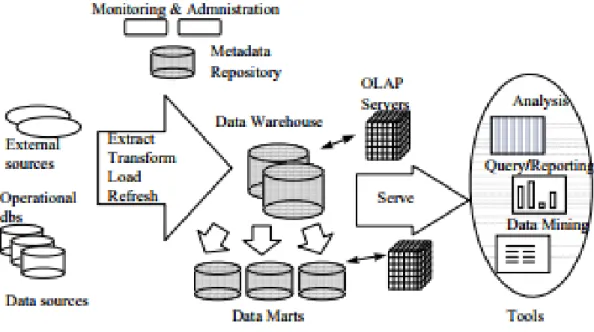
How Business Intelligence Can Raise Corporate Performance
- BI Efficiency in Management Accounting
- BI for Supply Chain Management
- BI for Online B2C Platform and Retail Organizations
- BI for Marketing and Promotion
This research takes into account one of the most modern approaches in BI – Big Data Analysis (BDA) and uses a statistical model to estimate the performance increase in companies that implanted BDA techniques. Some of the hypotheses in the research were: "BDA system quality has a significant positive effect on company performance", "BDA information quality has a significant positive effect on company performance" and "BDA business value has a significant positive effect on company performance". In the indicated paper, the results of the implementation of BI techniques in management accounting are not presented.
Moreover, it is obvious that management accounting, as a part of the business whose role is data analysis and presentation, will gain by implementing BI tools. Researchers investigated how using data analytics can improve the performance of two sides of the platform, demand and supply, and how it leads to improvement of the overall performance of the platform. Moreover, several other hypotheses in the article were tested, but they were not directly related to the company's performance in the scope of this study – the performance of the platform's users, i.e.
In order to examine all the hypotheses, authors have conducted a study in which general managers and sales managers of the companies that participate on the platform participated. The results of the study were that both demand-side and supply-side data analytics improve business performance for traders. One of the biggest sources for all companies, especially for those operating in B2C markets, is their customers.
In addition, data analysis applied to customer habits and activities allowed companies to increase overall understanding of segments and make advertising more efficient.
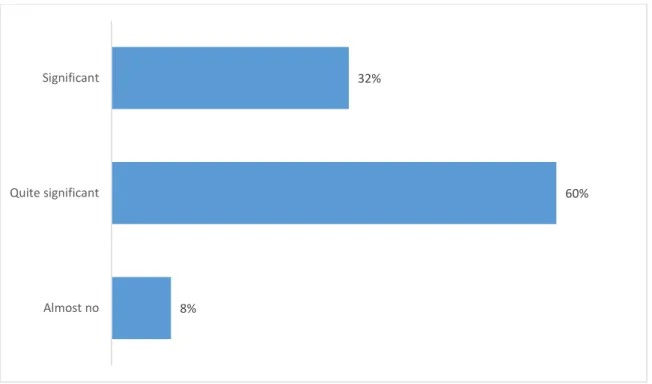
Research Gaps, Research Objectives and Questions
Several studies have been conducted in this area and one of them was made by Vidgen et al.15. This is not directly related to the topic of this research article, but among all the findings of Vidgen and his colleagues were several improvements in business performance achieved by companies from the case studies presented in the article (MobCo, MediaCo and CityTrans). All these improvements have been realized in the field of marketing and commerce and linked to improvements in other areas.
In the case studies it was mentioned that improvement in internal business processes opened an opportunity for companies to provide better services to their customers and that it improved overall satisfaction and attracted new customers. It has not yet been stated, but most of the research has been conducted in manufacturing organizations and departments, which are closely related to production (some studies on performance in Supply Chain Management were mentioned above). It has already been discussed how BI can help in Management Accounting and Marketing, but there is still a research gap in other areas of organizations (human resources, IT).
The research problem and research questions and research methods have already been stated in the Introduction. The goal of the research set in this paper is to check whether the use of a business intelligence solution improves the corporate performance of Russian companies in various areas. Furthermore, previous research in this area has typically focused on the subjective evaluations of managers and users of BI systems.
In addition, this research paper will include indicators of the company's performance, not only in the current state such as asset turnover or production efficiency, but also indicators that may affect future results.
Summary
31 investigated how BI developed over the years, and not only were scholarly articles written in this area, but books also exist that explore this issue. This paper sets out to investigate managerial and financial performance gains, the areas that are on the business side, but new methods such as neural networks or deep learning are still evolving (even though they were developed in the 20th century) and are not yet widespread implemented. not only in Russian companies, but also in Western ones.
Methodology of the Study
- Implications from Literature Review
- Research Design
- Case Study
- Semi-Structured Survey
- Financial Indicators Analysis
- Summary and Research Questions Revision
- Conclusion
In the survey, managers will be asked to assess how BI has also affected their companies' logistics departments. One of the research papers presented in the literature review was about evaluating how BI can change corporate performance in the field of marketing and promotion. Changes in these two indicators of corporate performance will be asked to be evaluated by managers in the survey.
Only the companies that installed BI solution two or more years ago were used in the analysis of financial indicators. So, it can be said that a complex BI solution has been installed in the company. A2: Every financial indicator will be higher one year and two years after the BI project than in the year of the project.
An example of the company that introduced BI in the form of a case study will be provided and the outcomes of this case study will be reviewed using semi-. This question is the main question and it will be explored in the case study and in the semi-structured survey. Moreover, several conclusions will also be drawn partly in the next chapter, but the most important.
Furthermore, managerial implications that can be derived from this chapter will be given in the last chapter.
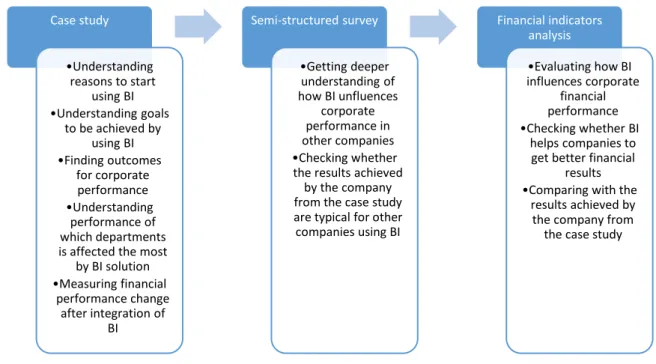
Empirical Study
- Data Description
- Case Study
- The Reason to Adapt BI
- The Scope of the Project
- Changes in Corporate Performance after Adoption of BI
- Survey Results
- Financial Indicators Analysis
- Summary
As mentioned in the chapter describing the research methodology, the case study of the company “RMNTK-Thermal Systems” was the main and primary source of information for further analysis. 49 the reason why we decided to start using BI in the company is to improve operations and stimulate growth. In the previous chapter, it was mentioned that RMNTK plans to conclude several important deals in the year following the year of BI integration.
First, the interviewee was asked to mention what changes in corporate performance they themselves noticed in the company. Despite growth rates that do not show that BI significantly affected the company's operations, two indicators changed better in the year and two years after the project compared to the year of BI project. The most important improvement achieved after the adoption of BI is in the level of managers' understanding of internal processes.
Financial indicators in the year of the project, one year after the project and two years after the project will be higher than the year before the project. Financial indicators one year after the project and two years after the project will be higher than in the project year. Secondly, many projects did not have a description and it was not possible to understand the scope of the use of BI in the company.
During the project year In the ear after the project Two years after the project. In the year of the project In the year after the project Two years after the project. These questions were not tested in the case study as they were outside the scope of the project, but were asked of respondents in the survey.
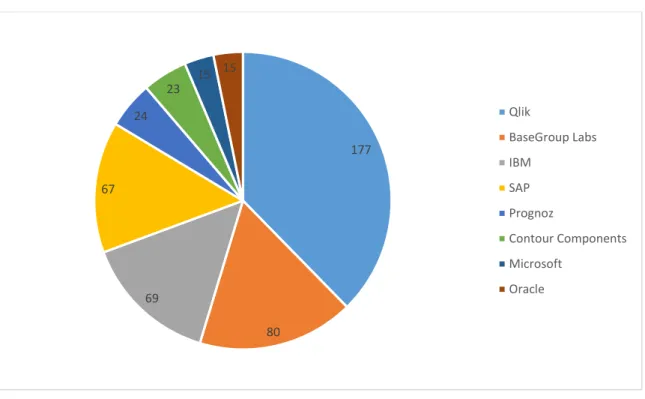
Research Results and Conclusions
62 The second question about whether and how financial performance of companies is affected by BI was answered in the last part of the empirical study. Despite most respondents in the survey answering that their companies' profitability and financial results were positively affected, objective analysis showed that this is not a pattern for all companies. In general, in half of the companies, each specific relationship can either improve or not after adopting BI and the chance of that is almost 50%.
In the empirical study, financial indicators were analyzed up to two years after the project and there was no sample that could be used for every company. It can be concluded from this that BI helps in the overall development of IT solutions in the company. As for the finance department, it also generates a lot of data and how it can benefit from BI is presented in a case study and in one of the research articles presented in the literature review.
Improvement of performance after adoption of BI has been achieved, but this does not correspond to financial results. According to the empirical study undertaken, designed in such a way that it provides both objective but general and subjective but deep results, the fact that corporate performance rises after integration of BI is proven. Retrieved from http://www.sas.com/en_us/insights/big-data/what-is-big-data.html.
Retrieved from: https://www.etechgs.com/blog/business-intelligence-helps-strategic-decision-making/. Business Analytics: What's the Difference.
Survey
Companies Whose Financial Indicators Were Analyzed

